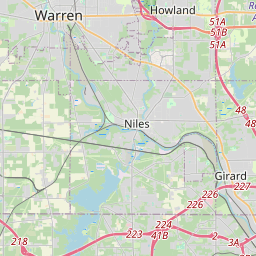Leicester King / The Underground Railroad on the Warren-Ashtabula Turnpike
Historical marker location:
Warren, Ohio
( Marker is on Mahoning Avenue, 0.1 miles north of High Street NW, on the right when traveling south.)







© OpenStreetMap contributors
Warren, Ohio (Trumbull County). Historic Underground Railroad Site
Loading...
Searching for other points of interest within 3 miles of this location.Ohio was the site of a major oil boom in the late 19th century, with oil wells producing millions of barrels of oil per year. The town of Lima, Ohio, became known as the "little giant of the oil industry" because of the large number of oil companies headquartered there.
About Trumbull County
Trumbull County Timeline
Trumbull County, located in northeastern Ohio, has a rich and diverse history that dates back thousands of years. The area was originally inhabited by various Native American tribes, including the Delaware and Wyandot, until the late 1700s when European settlers began to arrive. The first permanent settlement in the county was established in 1800 by James Hillman, and the county was officially formed in 1800, being named after Jonathan Trumbull, the governor of Connecticut.
During the early 19th century, Trumbull County played a significant role in the development of the Western Reserve, a region in Ohio that was surveyed and sold by the Connecticut Land Company. The county quickly became an agricultural hub, with farms growing crops such as corn, wheat, and dairy products. The completion of the Ohio and Erie Canal in the 1830s further facilitated economic growth, as it provided a transportation route for goods and opened up trade opportunities.
The late 19th and early 20th centuries brought industrialization to Trumbull County, with the discovery of vast coal and iron ore deposits. This led to the establishment of steel mills and factories, making the county a major producer of iron and steel during this time. The rise of the steel industry not only brought economic prosperity to the area but also attracted a diverse population of immigrants seeking employment in the mills.
However, the decline of the steel industry in the late 20th century caused significant economic challenges for Trumbull County. The closure of many mills and factories resulted in job losses and a decline in population. In recent years, efforts have been made to diversify the local economy and attract new industries to the area, such as healthcare, education, and technology.
Today, Trumbull County remains a blend of its rich history and ongoing efforts to adapt and grow in the modern era. With its natural beauty, recreational opportunities, and historical significance, the county continues to be a unique and vibrant place to live and visit.
During the early 19th century, Trumbull County played a significant role in the development of the Western Reserve, a region in Ohio that was surveyed and sold by the Connecticut Land Company. The county quickly became an agricultural hub, with farms growing crops such as corn, wheat, and dairy products. The completion of the Ohio and Erie Canal in the 1830s further facilitated economic growth, as it provided a transportation route for goods and opened up trade opportunities.
The late 19th and early 20th centuries brought industrialization to Trumbull County, with the discovery of vast coal and iron ore deposits. This led to the establishment of steel mills and factories, making the county a major producer of iron and steel during this time. The rise of the steel industry not only brought economic prosperity to the area but also attracted a diverse population of immigrants seeking employment in the mills.
However, the decline of the steel industry in the late 20th century caused significant economic challenges for Trumbull County. The closure of many mills and factories resulted in job losses and a decline in population. In recent years, efforts have been made to diversify the local economy and attract new industries to the area, such as healthcare, education, and technology.
Today, Trumbull County remains a blend of its rich history and ongoing efforts to adapt and grow in the modern era. With its natural beauty, recreational opportunities, and historical significance, the county continues to be a unique and vibrant place to live and visit.
Trumbull County Timeline
This timeline provides a glimpse into the major events and milestones that have shaped the history of Trumbull County, Ohio.
- 1800: Trumbull County is established on July 10, 1800, in the Northwest Territory.
- 1801: Warren, the county seat, is laid out as the first town in the county.
- 1805: The Youngstown area, which is now part of Trumbull County, is surveyed and divided into lots.
- 1808: Lewis Kinney builds the first furnace and forge at Niles, beginning the area's iron industry.
- 1831: The Pennsylvania and Ohio Canal is completed, passing through Trumbull County and aiding in transportation and trade.
- 1856: The Atlantic and Great Western Railroad (later part of Erie Railroad) reaches Warren, connecting the county to the national rail network.
- 1862: Niles becomes a center of iron production with the construction of the Niles Iron Works.
- 1870: Trumbull County's population reaches over 50,000, driven by industrial growth and immigration.
- 1895: Packard Electric Company is founded in Warren, becoming a major employer and contributor to the automotive industry.
- 1905: Warren G. Harding purchases the "Star" newspaper, launching his career in politics.
- 1953: The Trumbull Art Gallery is established in Warren, promoting the arts in the county.
- 1977: The Youngstown-Warren Regional Airport opens, improving regional transportation.
- 1998: The Trumbull County Courthouse is renovated, preserving its historic architecture.